White Paper
Field-Led Customer Journeys in Life Sciences:
A Blueprint for Making It Happen
1. The imperative of integrated customer engagement planning
It’s never been more important to deliver a seamless customer experience — and in today’s era, this requires teams to plan, design, execute, and track customer journeys across physical and digital channels, at scale. Over the past five years, competition has become fiercer, markets are increasingly complex, and healthcare professionals (HCPs) continue to demand engagement on their terms. In this context, being able to orchestrate business-driven, customer-centric journeys is a strategic imperative.
Biopharma companies have most of the pieces in place but often struggle to connect their systems, data, processes, and people. Without these key enablers, it is not feasible to offer customers personalized, informative, and impactful experiences in a scalable way.Integrated customer engagement planning will lead to enhanced business results, as well as other leadingindicator benefits:
- Improved CX through the execution of one holistic customer engagement plan
- Better HCP activation and conversion
- More granular measurement of journeys, their impact, and what works (and what doesn’t)
- Higher-quality data to enable AI
- Empowered field teams to deliver personalized experiences
- Improved field user experience (UX) through one easy, integrated solution
- Greater RoI from technology investments
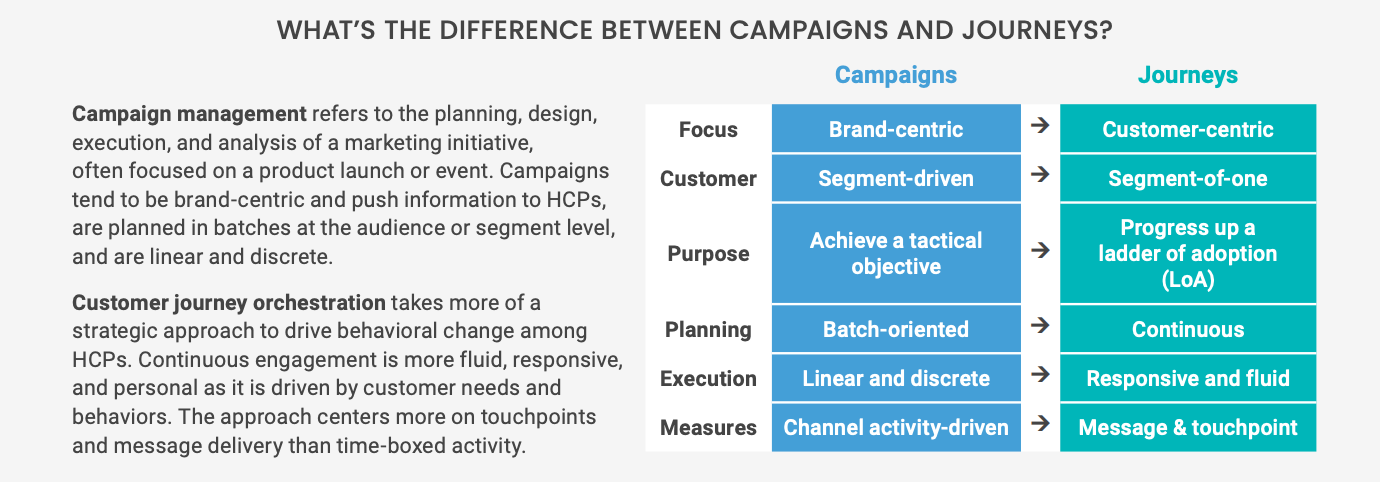
2. Overcoming existing barriers
Biopharma companies continue to invest heavily in improving how they go to market and engage with HCPs. This comes in many forms: optimizing channel usage, investing in modular content, enhancing content effectiveness, capturing better HCP insights to drive greater personalization of content and messaging, and automation to increase responsiveness. However, despite best efforts, there are three significant barriers to overcome [Figure 1].
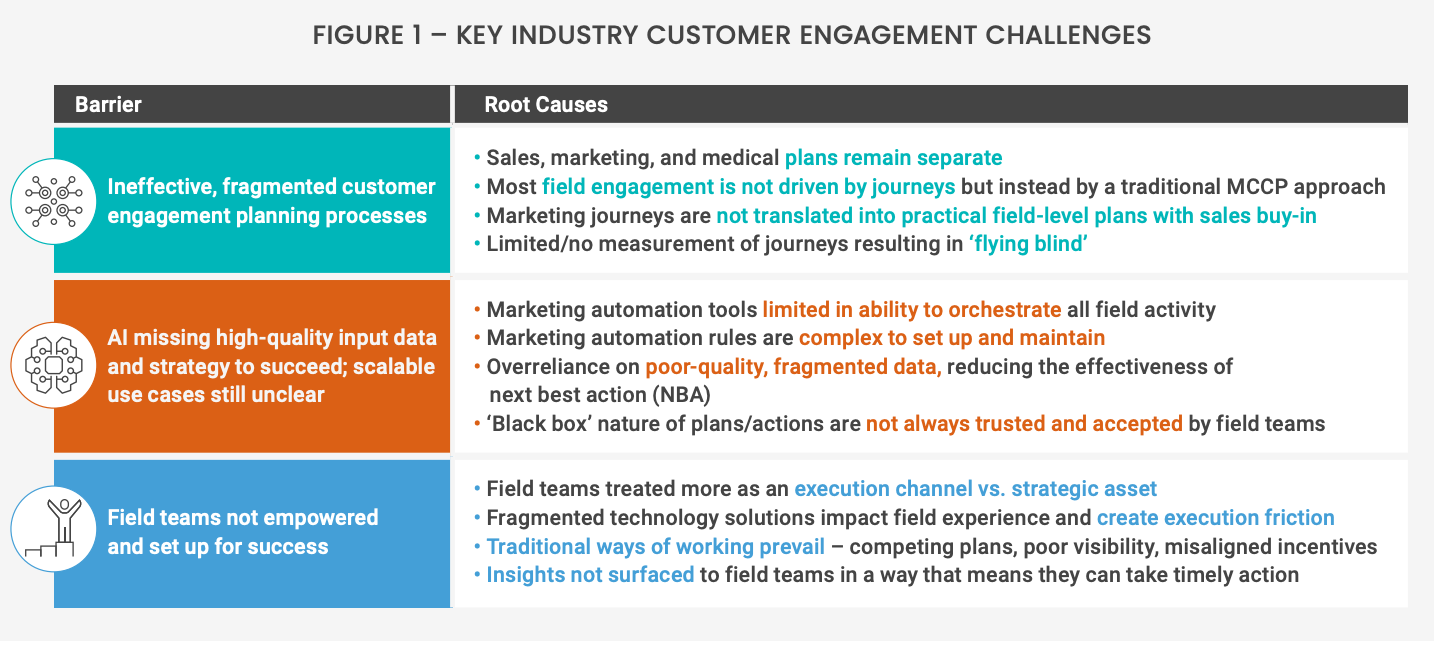
True customer journey orchestration will remain out of reach unless these challenges are addressed directly and holistically. Each issue can be overcome with a new end-to-end approach, supported by the right technology, processes, skills, behaviors, and performance measures. Equally, finding the right balance between human intelligence and technology will be critical, so that journeys can be adapted to customer needs. It all starts with a fresh lens on where investment, focus, and effort are being directed today.
Focus investment in the right places
Traditionally, marketing teams in biopharma lead the design of customer-centric journeys, while sales drives field activity through a cycle planning process to ensure top prospects are regularly seen. This approach usually means that a single customer plan doesn’t exist, which results in sales, marketing, and medical functions operating in relative isolation.
For instance, sales focuses on personal, field-led channels and marketing on digital channels (such as web/portal, mass email, and social), while increasingly relying on marketing automation to enable personalization. Add medical into the mix, which follows yet another process, and the result is fragmented journeys that fail to deliver impact.
To reassess your current approach, we recommend asking yourself the following questions:
- What proportion of your overall customer touchpoints is driven by marketing automation?
- How many HCPs regularly visit your portal/web and are they identifiable?
- Does mass email have more or less impact than field-led email?
- Does activity attainment or touchpoint and message delivery drive field planning?
- How many suggestions/NBAs are sent to field teams and how many do they act upon?
In our experience, most biopharma companies tend to answer a) Less than 10%, b) Very few, c) Less impact, d) Activity attainment, and e) Lots, but few are actioned.

It is normal for sales and marketing to focus on planning for only those channels within their remit but doing so leaves significant value on the table. In Figure 2, Veeva analysis indicates that most of the engagement volume a biopharma company has with its HCPs can be classified as ‘Personal planned’ (the orange box). Veeva Pulse data shows there are 600m+ personal interactions with HCPs annually. While marketing automation and NBA have important roles to play, they are typically lower in volume (for now) and delivered via less impactful channels (than personal, for example). It is essential to get the most out of personal interactions, as they can have a higher impact.
Biopharma companies can drive significant business value and improve the customer experience by finding a better balance of investment across this matrix, including introducing marketing-led journeys to personal-planned engagement. The data generated can greatly improve the effectiveness of marketing automation and NBA, but a lot of valuable insight is left untapped today (see ‘The journey to AI-driven orchestration’).
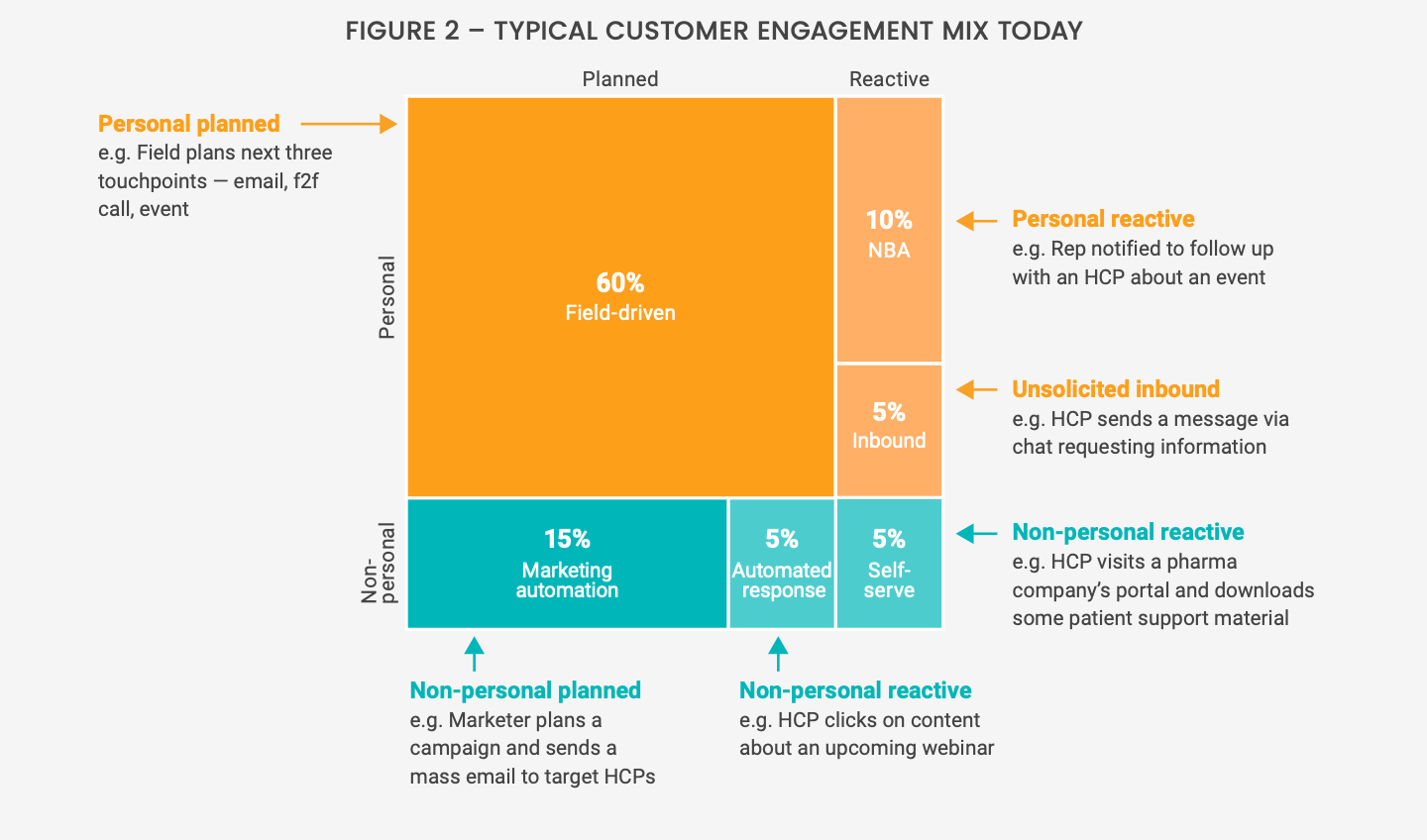
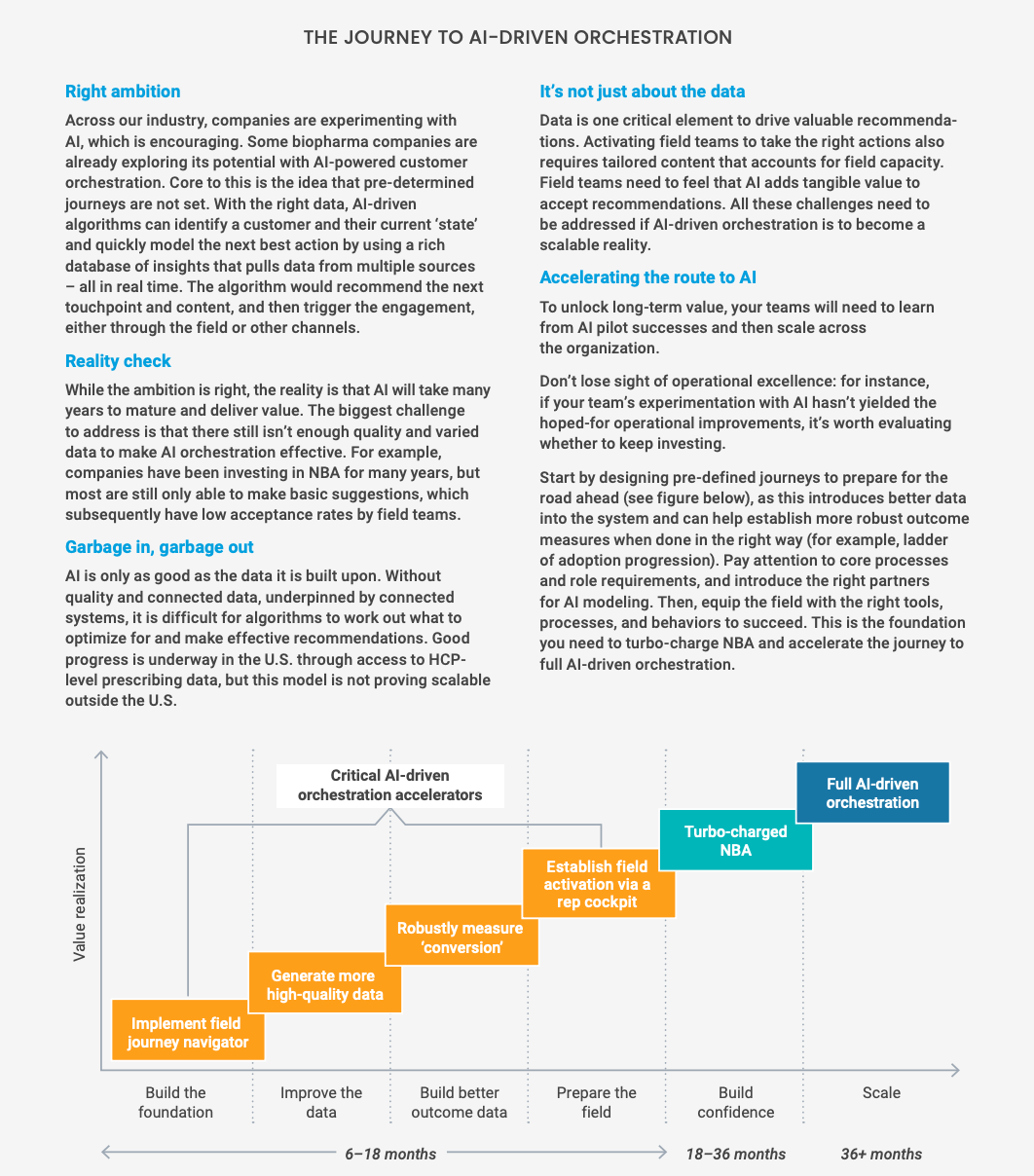
3. Rethinking the blueprint for execution
To realize the full potential of customer journey orchestration, biopharma companies need a new approach that challenges traditional ways of working, silos, and mindsets [Figure 3]. Although a significant change, it is more evolution than revolution. To unlock this opportunity, the current process needs an infusion of targeted solutions, each of which helps address historical barriers.
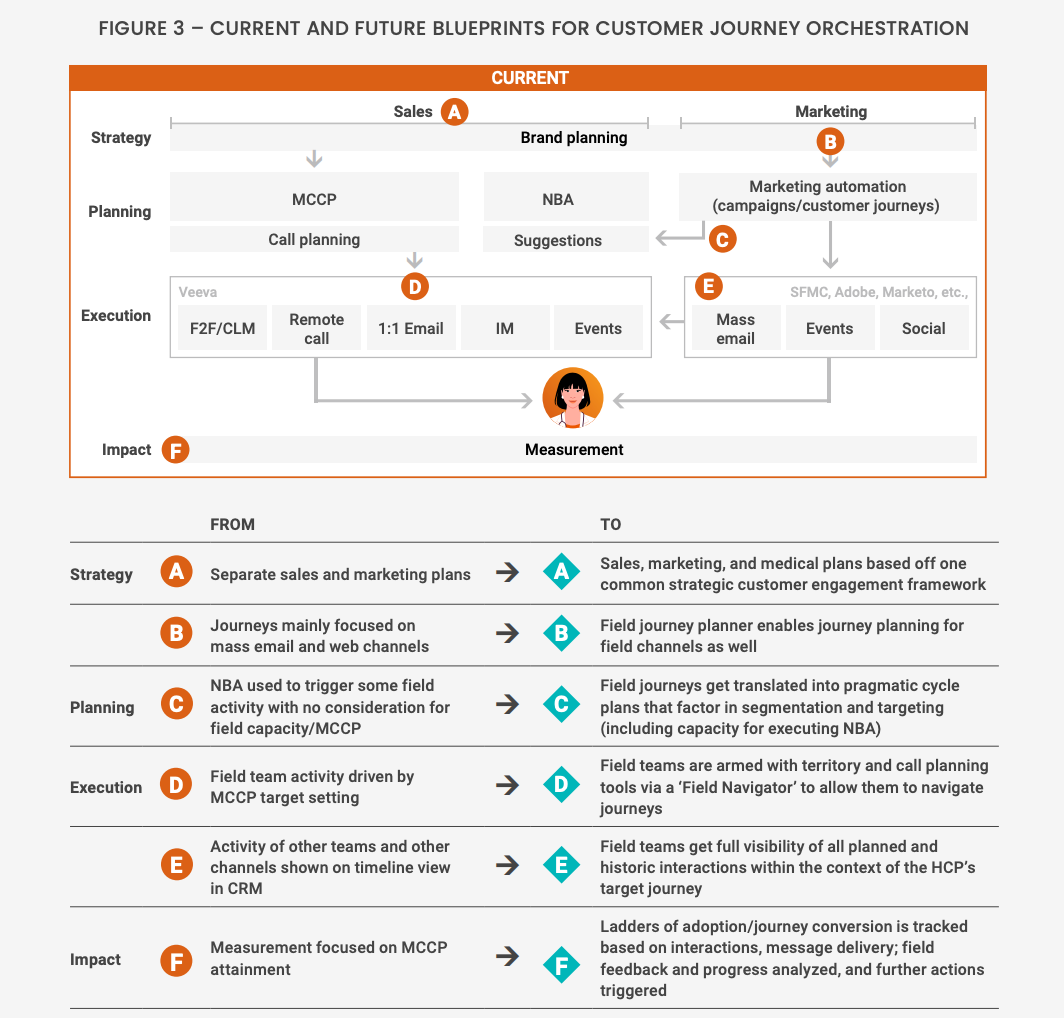

4. A new approach to customer journey orchestration
Naturally, technology is a critical enabler in this future model, but it is insufficient on its own. There are five steps to overcoming muscle memory and embedding this new approach, which span adapting your processes and ways of working; introducing new performance measures; and evolving the skills and mindsets of sales, marketing, and medical [Figure 4].
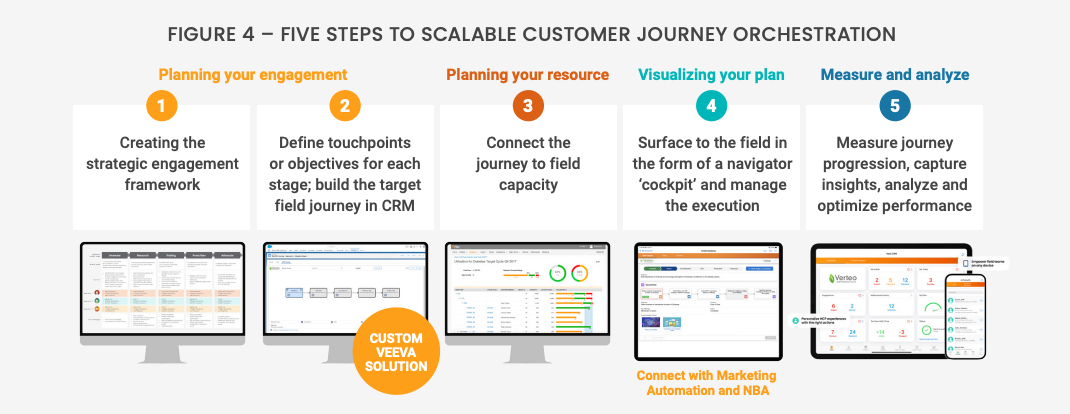
STEP 1
Create the strategic customer engagement framework
Start with a strategic customer engagement framework that spans sales, marketing, and medical. This framework should guide how these teams design journeys for each customer segment, based on progress up a ladder of adoption or influence. For each stage of the journey, define a series of objectives, messages, and content that should guide the field to engage in a personalized way reflecting both brand strategy and HCP needs.
Having a common framework is essential to align field-led journeys with marketing campaigns and automation journeys. For simplicity and execution efficiency, avoid the trap of trying to plan one integrated journey across field and digital. Field planning is different: complex and costly, it will be inefficient to try and design sub-journeys that are automatically triggered for field teams to execute. An approach that provides end-to-end visibility, while leaving some discretion to highly skilled and knowledgeable field teams, will be more effective. Over time, as data quality improves, AI may be able to orchestrate more of the journey, but this is a long way off today.
A common framework ensures consistency across field-led and marketing automation journeys while avoiding the complexity, sophistication, and cost of designing one journey for all stakeholders.
STEP 2
Build the journey in CRM
Once the framework is ready, it’s easier to design and codify the journeys into CRM using a user-friendly visual tool (e.g., a custom Veeva configuration), and tailor for different products, adoption ladder stages, and HCP segments. This addresses the recurring problem that most marketing outputs stay in PowerPoint (or similar formats) and lack influence over field activity.
If the framework is in CRM, the underlying data can be utilized to guide and optimize field planning. It becomes easier to track journeys and significantly enriches the available insights. For this to be feasible, it’s critical to have one common data model across all brands and markets to account for different ways of working and difficulties in measuring effectiveness.
STEP 3
Translate journeys into field-level plans
Effective digital engagement acknowledges that field teams have finite capacity, factors in prioritization, and facilitates advanced planning so daily and weekly schedules can be created. For example, commercial field teams in the U.K. might only be able to see a particular HCP three times per year. It’s critical to factor these types of real-world constraints into individual HCP journey plans.Setting up field cycle plans is predominantly a datadriven exercise. But if journeys are already defined, all that data exists in the system. This data can be leveraged and supplemented with some prioritization criteria and field capacity data to simplify the cycle planning process. The output is a realistic plan for a field team member for their territory going into the next cycle, which recommends the appropriate journey for each HCP based on where they are in the adoption ladder, their value segment, and the next step of the journey. Field teams need an opportunity to provide feedback on this process and include their qualitative knowledge, before locking in a plan that they are comfortable with and is ready for execution.

STEP 4
Enable field planning via a user-friendly navigator ‘cockpit’
At this stage, journeys are planned at the HCP level and locked into field teams’ cycle plans. Provide field teams with all the insight and direction required to plan and schedule engagement, and then execute the journeys. They need a single, go-to place to plan their activity and calls — almost like the navigation cockpit of a plane. For complete visibility, it is important that nonfield-driven interactions are also surfaced on the HCP timeline. Suggestions/NBAs can then trigger field-led marketing activity.
STEP 5
Measure and analyze
A key benefit of this new approach is the ability to measure and analyze journeys at a granular level so that you can continuously optimize the customer experience. Field teams can use the navigator ‘cockpit’ to track individual customer journey progress and access territory views on journey status and progression. This enables tailored engagement, both within and between cycles. Field teams find it easier to pick up the next touchpoint with an HCP when journeys are tracked automatically in this way.
Introducing more robustness and objectivity when measuring ladders of adoption could result in more impactful measurement. Data captured from these activities can be combined with field feedback and other data sources to track customers’ level of adoption, ensuring a clearer lens on their status than relying on self-reporting alone. Finally, data captured can also be used to trigger marketing automation, which ensures marketing journeys are joined up without the need for integration.
5. Making it happen
It’s time to accelerate the transition to this new model. Execution is what matters most, requiring a shift from strategy and capability building to scalable execution and value realization. Fortunately, most biopharma companies have 90% of the pieces in place to enable this today, but it is time to translate the vision and strategy into practice, get the organizational blueprint right, and then drive lasting change.
The roadmap to customer journey orchestration leadership [Figure 5] needs a clear direction and set of accelerators to mobilize (Phase 0), followed by embedding the right foundations (Phase 1), before accelerating to market leadership (Phase 2). With the right dedicated focus and leadership alignment, biopharma companies can be up and running within four to six months.
By combining marketing’s omnichannel engagement expertise, sales’ experience with field management and capacity planning, and field’s unique customer insight, biopharma companies can capture significant value from their omnichannel engagement. This will provide a more personalized experience for their customers — and deliver tangible in-year business value.
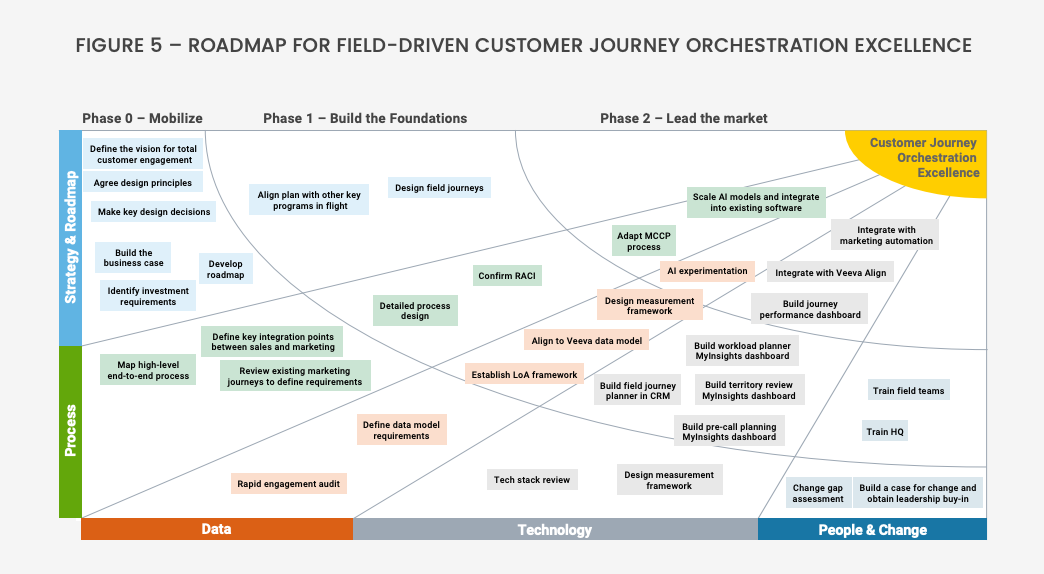
Key Takeaways
10 DESIGN PRINCIPLES OF JOURNEY ORCHESTRATION EXCELLENCE
- Shift the focus to touchpoints, messages, and content – Rather than channel activity
- Don’t be too prescriptive – Trust and empower your field force to know their customers and take the lead on delivering a personalized experience
- Use marketing automation and NBA as accelerators – Balance investment in these areas and use them to help accelerate journey progression with relevant actions
- Improve robustness of ladder of adoption measurement – Moving beyond self-reporting ensures that the right messages are delivered to the right customers at the right time
- Plan for cycles, not events – Cycles are well understood by the field while events can be integrated within the planning cadence
- Enable customer prioritization within journeys – Align with sales on segmentation to be used with journeys and leave personas to guide content choice
- Factor in capacity – Even the perfect engagement plan will be ignored by field teams if it’s not realistic within their existing sales cycle
- Enhance the field team experience – Providing visibility is insufficient without considering the UX design of your solution
- Systematically measure journeys - Shift journeys from PowerPoint and design them based on data within CRM
- Make it scalable and cost-effective – The most advanced approach will have limited impact if isolated to a few brands or markets
Learn how the Vault CRM Suite unifies sales, marketing, medical, and service on a single life sciences-specific platform to drive more effective HCP engagement.
Authors
Aaron Bean
VP, Business Consulting Lead, Europe
aaron.bean@veeva.com
Gareth Allott
Principal, Business Consulting
sam.prince@veeva.com
Sam Prince
Senior Consultant, Business Consulting
sam.prince@veeva.com
About Veeva Business Consulting
Veeva Business Consulting combines commercial and medical expertise with Veeva's proprietary data and technology to deliver better business-focused solutions for our customers. Our team of experts offers a suite of advisory offerings, including launch readiness, digital acceleration, and content optimization, all supported through unique HCP insights and analytics.
To learn more, visit veeva.com/business-consulting.